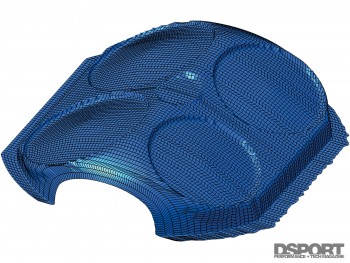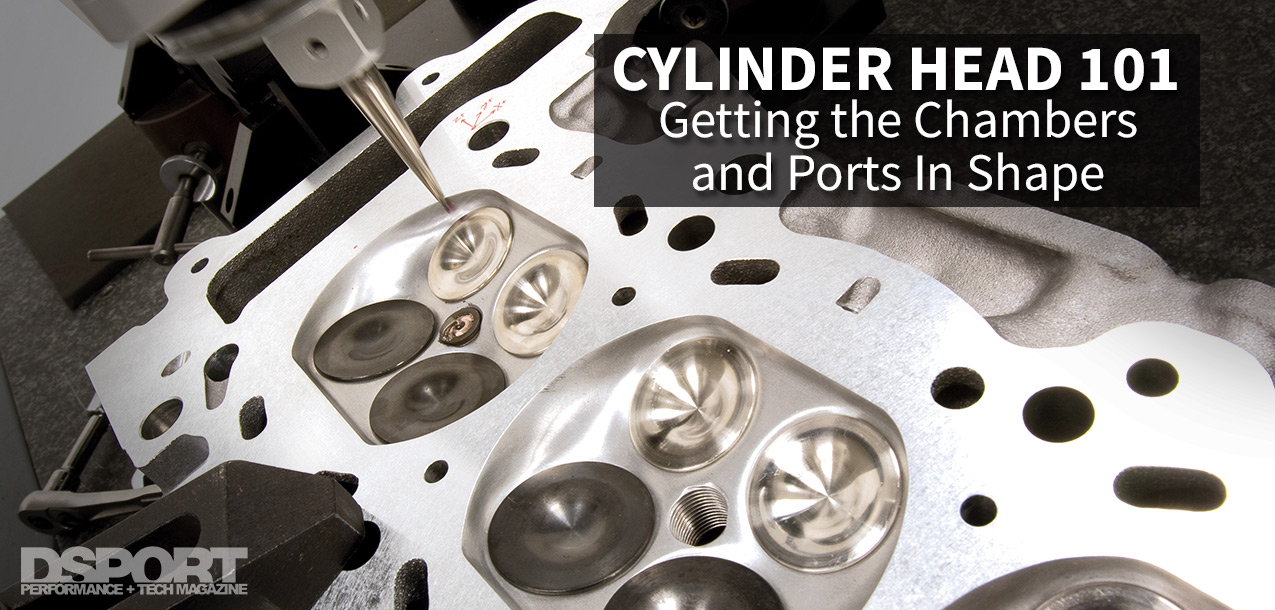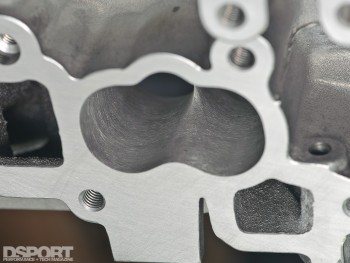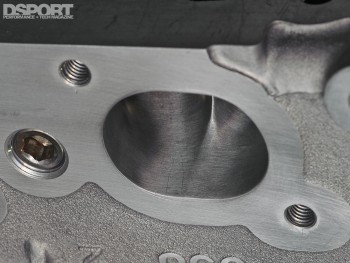Removing Intake Squish Pad
When giant injectors are being used and the fuel isn’t being properly atomized, the larger droplets of fuel can induce detonation. Physically removing the squish pad on the intake side of the combustion chamber is often a good band-aid solution when improving fuel atomization isn’t an option. Just remember that any machining of the combustion chamber will reduce compression ratio if the piston isn’t designed to make up for the larger volume in the chamber.
Digitized and Profiled
 Many of today’s leading high-performance piston manufacturers can customize piston crown profiles to be optimized to the shape of the combustion chamber. Of course, having your combustion chambers treated to a quality CNC processing will help to ensure that the clearances are at a closer tolerance and are more consistent. When possible, sending the cylinder head to the custom piston manufacturer will allow the actual chamber to be digitized. In lieu of this option, there are some kits available that allow an engine builder to make a mold of the cylinder head’s combustion chamber. This mold can then be sent to the piston manufacturer to be digitized. Of course, just obtaining the proper quench clearances will help to improve performance, if custom pistons are out of your budget or timeline. For those that want the ultimate in performance and economy, the extra investment in time and money may be just what you need to set a record.
Many of today’s leading high-performance piston manufacturers can customize piston crown profiles to be optimized to the shape of the combustion chamber. Of course, having your combustion chambers treated to a quality CNC processing will help to ensure that the clearances are at a closer tolerance and are more consistent. When possible, sending the cylinder head to the custom piston manufacturer will allow the actual chamber to be digitized. In lieu of this option, there are some kits available that allow an engine builder to make a mold of the cylinder head’s combustion chamber. This mold can then be sent to the piston manufacturer to be digitized. Of course, just obtaining the proper quench clearances will help to improve performance, if custom pistons are out of your budget or timeline. For those that want the ultimate in performance and economy, the extra investment in time and money may be just what you need to set a record.
Running the Mill or Doing the Grind
For a hassle-free seal of the head-gasket, both the cylinder head and cylinder block must be as flat as possible. In addition to being flat, MLS gaskets also like a surface to be as smooth as possible. Grinding of the block and head will provide a smoother surface than can be obtained by milling. In fact, we take our blocks and heads to a grinding specialist for an ultra-smooth surface. Some engine builders also mill or grind the block to establish the desired deck clearance and combustion chamber volume. Be careful not to remove too much material from the cylinder head as the deck can become too thin and the head may distort. In addition, milling the head will reduce piston-to-valve clearances, so be sure to check this clearance.
Porting: Opinions, Opinions
When it comes to porting cylinder heads, everyone seems to have an opinion. The reality is that if ported-cylinder-head “A” delivers more performance than cylinder head B when placed on an identical engine on the same dyno, then A is better than B for that application. Of course, that’s a pretty difficult way to test a cylinder head. Instead, the industry relies on flow benches.
While flow benches can be an incredible development tool, flow numbers alone don’t tell the whole story. Flow numbers are a lot like peak dyno figures. A higher peak number in either case doesn’t necessarily translate into the better performing engine. Each flow bench reads a bit differently too, making it impossible to compare figures across two benches.
Here’s another way to look at it. Flow benches measure the volume of air flowing during a period of time for a given valve lift. Let’s say the flow bench measures 200cfm of flow through the intake port on a certain head at 0.400-inch of valve lift. Another head that measures the same flow at 200cfm at that same valve lift may perform better or worse based on its flow ratings at other valve lifts and the flow velocities.





